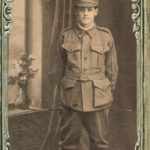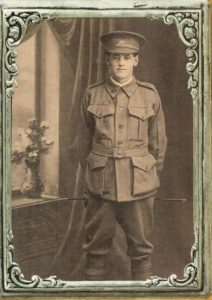Wheeler Project – Reflections
Annie Wheeler’s index of Central Queenslanders serving in the Australian Imperial Force (A.I.F.) has enabled Genealogical Society of Queensland (GSQ) volunteers to document the lives of more than 2,700 Australian men and women who fought and died and World War I. Their service records, housed in the National Archives of Australia (NAA), show the diseases from which they suffered – scabies and diarrhoea, trench foot, venereal disease, influenza and tuberculosis – as well as the battle injuries that either killed them or left them permanently disabled or disfigured. Examination of these records inevitably raises questions about the circumstances in which many of them died. Some of these questions are explored here.
Graphic descriptions of battle conditions in the main European theatres of war (France, Belgium) suggest that soldiers and nurses served in appalling conditions: rain- or snow-filled trenches, knee-deep mud, constant shelling that wounded both men and animals (horses were extensively used by the A.I.F.). Many died in the mud, in their own blood and excrement; their bodies lay where they fell, sometimes not recovered for years. How, in such conditions, were their remains identified?
In the 1914-1918 war, Australian soldiers were issued two identity discs (progenitor of today’s ‘dog tags’), one red, one green: red for blood, green for earth. When the remains were recovered, the green disc was intended to accompany the deceased to the burial site; the red disc was to be returned to the grieving family along with the contents of the soldier’s ‘kit’ (personal effects such as badges, diary, belt, canteen,watch, spectacles, knife, sword) with a letter to the family of the ‘fallen’ indicating the place of burial, often no more than a hastily dug grave on the battlefield, marked by whatever identification was recoverable.
In some instances, the effects returned to families did not include the identity disc, which suggests that identification had to be established by other means. Some were tentatively identified through letters found with the deceased that included the name of a family member, or through the testimony of fellow soldiers or nurses who witnessed the death and were able to verify the identity of the deceased and circumstances of the death. After positive identification was made, the remains were re-interred in a military cemetery, and the family was informed of the location of the permanent resting place of their loved one (including plot, row and grave number). And when positive identification could not be established? The remains were reverently re-interred, with a marker indicating ‘Unknown’ and the date of burial. There are thousands of such graves in British, Canadian and Australian military cemeteries in or near French and Belgian towns.
Army records of those killed in action suggest another disturbing aspect of death in war: the need to convey in sensitive language the circumstances surrounding the death. In most cases, the records of soldiers killed in action include the phrase ‘died of gunshot wound received in action’ or ‘succumbed to wounds (or illness)’, but in other cases the official record contains only the date and place of death and the phrase ‘official investigation conducted’. Many families, determined to learn more about the death of a loved one, plied Army officials with letters requesting details of the investigation. Official responses suggested that the death was attributable to an enemy action the like of which today would be regarded as an atrocity, a war crime.
One such death is that of a 27-year old former school teacher serving near Bapaume in 1917, killed in an explosion when retreating German forces packed dynamite in tunnels under the town hall and triggered the explosion when the area was full of civilians and Australian soldiers. This man’s story is told by Geoffrey Robertson QC in his book Dreaming Too Loud (Random House Australia, Vintage Books 1913). The soldier’s remains were discovered 14 years after his death, his identity established by means of the name inscribed on a watch given him by his pupils before he went off to war. He was one of 19 Australians and scores of Bapaume residents killed in the explosion. Their deaths were commemorated in 2011 when the town’s leaders tracked down the relatives of the 19 Australian soldiers and invited them to the unveiling of a memorial. Robertson notes that those with command responsibility in the German Army would have been prosecuted for the ‘scorched earth’ tactics they employed as they retreated – poisoning wells, cutting down fruit trees, setting time bombs – had the British, French and Australian demands for justice not been overruled by an American President (Woodrow Wilson) intent upon magnanimity towards the vanquished, in the hope that a post-war league of nations would prevent future conflicts.
NAA files of A.I.F. soldiers include heavily censored letters to and from Australian prisoners of war lamenting inhumane treatment – lack of food and medical treatment, substandard sanitary conditions – which today would be considered war crimes as defined under the Geneva Conventions (1948). The universal values embodied in the Genocide and Geneva Conventions for protecting prisoners of war, together with the Universal Declaration of Human Rights “form the great post-war human rights triptych, setting out the basic principles by which state action should be judged…they are universal because their denial in one country, or even in one town, affects and shames us all” (Robertson, p 264). Australia’s Herbert ‘Doc’ Evatt, President of the U.N. General Assembly in 1948, played a crucial role in formulating and promoting acceptance of these important declarations of human rights.
As Australia Day approaches, it is fitting to remember the sacrifices of the men and women of the A.I.F., to whom Annie Wheeler devoted years of her life, recording their contributions to Australia’s war effort in the hope that their lives would have meaning long after their deaths. The Wheeler records will be available on the GSQ website in mid-1917
Seasons greetings,



Geraldine I hope we find the name of this soldier so that he doesn't remain "unknown" for much longer